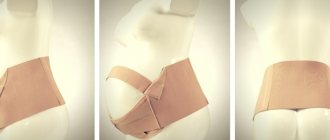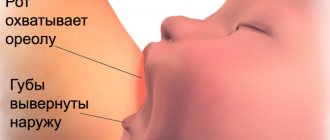The female body endures a lot of stress during pregnancy and therefore needs additional care and attention. Usually girls complain of back pain, heaviness when walking and divergence of the pelvic bones. To relieve discomfort, women wear a bandage.
A maternity bandage is an orthopedic product that resembles an elastic corset. It helps ease the pregnancy process and promotes healthy fetal growth. Usually the doctor prescribes wearing it at the 30th week of pregnancy. However, there are girls who begin to wear it of their own free will.
The bandage can be worn after pregnancy to quickly restore the healthy size and tone of the uterus. Thus, a woman gets into shape faster after pregnancy.
Why wear a bandage?
The main function of a prenatal bandage is to maintain the abdomen in the correct position. By wearing such an elastic belt, the fetus takes a healthy position inside the uterus, which prevents problems during childbirth. Also, the bandage is a prevention against postpartum stretch marks. The corset also acts on the spine while walking, reducing the degree of stress on the body. This reduces pain in the lumbar area during pregnancy.
Experts recommend the bandage to be worn by expectant mothers who lead an active lifestyle. A doctor may prescribe it for varicose veins, osteochondrosis and other ailments that occur during pregnancy.
Some women buy a bandage on their own initiative, but this should only be done as prescribed by a specialist. This is done because there is a small number of contraindications, for example, incorrect position of the fetus in the third trimester.
The doctor prescribes wearing a bandage during pregnancy if:
- Back pain
- Repeated pregnancy
- Osteochondrosis
- Curvature in the lower back
- Multiple pregnancy
- Diseases of the genitourinary system
- Low position of the fetus
- Risk of miscarriage
A postpartum bandage helps restore weakened abdominal muscles and promotes contraction of the uterus. Doctors usually prescribe it to women after a caesarean section to protect stitches.
This type of product is made from a more elastic and dense material. The bandage provides the necessary level of compression to effectively support the abdomen, restore the tone of the abdominal muscles, thereby reducing the size of the uterus.
Therapeutic and hernia bandages
Who prescribes wearing a bandage and in what cases?
Depending on the severity of the damage to the muscle tissue of the abdominal area, the prescription is prescribed by an orthopedist, surgeon, gynecologist or urologist.
The bandage is selected with the functions of temporary support, preventive treatment or permanent wear. Reasons for wearing a bandage:
- hernias;
- muscle strain due to excess weight;
- pelvic muscle injuries;
- abdominal surgery;
- pregnancy;
- postpartum changes;
- muscle discrepancies due to long-term illnesses.
Conventionally, all types of bandages are divided into therapeutic and hernia. The first is prescribed for a wide range of muscle damage due to injury, surgery or age-related changes. The therapeutic bandage is worn as temporary support during the recovery period.
The hernia type of bandage is aimed at a group of diseases during which a hernia appeared. The task of support is to eliminate the load and keep the internal organs in their original position. By wearing a hernia bandage, displacement of organs is excluded, which can cause the development of side diseases.
Therapeutic bandages
Therapeutic bandages have several directions. One of them is displacement of internal organs when the outer wall of the abdomen is stretched. Loss of tone can occur due to sudden tension, which leads to stretching of the muscle frame. The second cause of the problem may be excess weight. Under the weight of the layer of fat, the skin and muscles are pulled down. Because of this, there is a loss of tone not only of the outer wall, but also of the internal smooth muscles.
The second type of therapeutic bandage is prescribed for injuries or operations on the lower abdomen. The purpose of the device is to perform work behind the muscular frame, to keep the seam area from damage. A separate type of bandage is prescribed for injuries to the anus, rectum or muscles and pelvic organs. In this case, the bandage has additional fasteners that pass through the groin area.
Goals and objectives of wearing a therapeutic bandage
The purpose of wearing a therapeutic bandage:
- provide support to the muscle and ligament system;
- exclude the possibility of pain;
- eliminate the cause of pressure on the damaged area;
- promote recovery;
- support the body until the end of therapy.
The purpose of wearing a therapeutic bandage is to return the muscles to the ability to support weight on their own. Do not allow the organs to change position. Fix the anatomically correct position of muscles and ligaments. Reduce stress on joints and prevent the formation of side diseases.
Bandages for pregnant women: from when to wear them?
Bandages for pregnant women are a separate product line. It is prescribed at the first signs of deterioration in the muscular framework of the mother’s abdomen. This is a necessary measure to preserve the health of not only the mother, but also the baby.
Rendering for appointment:
- multiple pregnancy;
- pinching of the sciatic or lumbar nerve;
- surgery performed on the abdominal cavity or uterus;
- muscle separation after prolonged labor;
- scars on the uterus;
- risk of miscarriage;
- underdeveloped uterus;
- frequent exercise, standing.
A women's maternity bandage can be in the form of a band, panties, a "tummy" or a universal half-corset. Consists of an elastic band with fasteners. The wearing period is determined by the gynecologist. In some cases, it is prescribed at the first sign of illness. At the 20th week, wearing it stops, as this can negatively affect the condition of the fetus.
Hernia bandages
An abdominal hernia is a mechanical damage to muscle fibers, in which internal organs protrude into the spaces between the fibers. Hernia bandages differ from therapeutic ones in the type of structure. They necessarily contain a seal that pushes the organs emerging into the lumen back.
Hernia bandage models:
- umbilical hernia bandage;
- left-sided inguinal;
- right inguinal;
- hernia bandage for back support;
The hernia band performs the function of support and treatment. Fitting tightly to the body, it relieves tension on the muscle frame. That is why it is performed in an anatomical manner. All types are divided into children's and adult bandages. Children under 5 years of age are often prescribed an umbilical clamp, since the umbilical lumen does not close well on its own. The duration of wearing the device depends on the individual speed of recovery of the problem area.
How to choose a belt?
The type of device is prescribed by the attending physician. To be worn comfortably on the body, the bandage must allow air to pass through. It is desirable that the fabric has sweat-wicking properties, since the bandage is worn for a long time.
The width of the belt is selected according to the patient’s body shape. It is not recommended to purchase a device without trying it on. The belt should not create discomfort on the body, seams and joints should not rub. Particular attention is paid to fastening and adjusting belts. The fittings must snap tightly to prevent accidental unfastening.
How to use it correctly?
- The support device is put on while lying down.
- In the case of a hernia, a gentle massage is performed in a lying position before dressing. The bulge is gently pressed into place. A pelot is applied to this place.
- The bandage is worn during the daytime for no more than 3-4 hours.
- Continuous wearing of the device is permitted only before surgery.
- Tight wearing is allowed for no more than 1 year, then the tension is gradually weakened.
Maternity bandage
There are a huge number of maternity bands on the market today. For example, bandages can be in the form of panties or a belt.
Types of prenatal bandages:
- A corset for pregnant women is a tightening belt.
- The bandage belt is a wide elastic band that is secured under the abdomen with Velcro. The model fixes the uterus without creating pressure from above. Usually the doctor prescribes a bandage belt for severe back pain. If you wear the right model, your belly will look like it’s in a basket.
- Bandage panties are made of very elastic material. This model supports areas under the abdomen and lower back. Bandage panties have fixed sizes, so as the abdomen increases, it may become necessary to replace them.
- The universal maternity bandage can be worn before and after pregnancy. When worn during pregnancy, the narrow side of such a belt should be located on the stomach, and the wide side on the lower back. After childbirth, the belt should be worn in the reverse position.
Why are bandages needed?
A post-operative bandage is a wide elastic belt worn over the area where surgery was performed. Often, such additional support is prescribed after hysterectomy, gastric resection, gastrointestinal surgery, hernia removal, liposuction, and other plastic surgery on the abdominal area. The corset performs several important functions:
- prevents organs from moving inside the abdominal cavity, maintaining them in the desired position;
- reduces the healing time of sutures;
- protects unhealed sutures from infections;
- prevents the occurrence of hernias (this happens after operations, when organs, without additional support, “stick out” from the abdominal cavity);
- prevents stretch marks from appearing, has a positive effect on restoring the elasticity of the skin;
- prevents hematomas and swelling from appearing;
- minimizes pain.
One of the additional functions of the abdominal girdle is the regulation of range of motion. On the one hand, it prevents you from making too sudden movements, which are dangerous in the postoperative period. On the other hand, it maintains mobility, the patient gets to his feet easier and faster, it is easier for him to walk, sit down, stand up, and perform other movements without excessively straining the postoperative area.
How to put on a maternity bandage correctly?
The bandage is put on so that the narrow part of the product should be below the abdomen, and the wide part should be on the lower back and help maintain the back in a healthy position.
For the first time, it is better to put on the bandage while lying down, raising your hips - in this position, the abdominal organs will be able to take the correct position.
How to put on a bandage:
- Place the product on the bed
- Lie on the bandage with your back, raising your hips for a few minutes
- Lower your hips
- Lie down for a few minutes
- Fasten the bandage so that your palm fits between it and your stomach.
After getting out of bed, you will feel that your stomach has become lighter and your back has stopped hurting. Wearing a bandage will make it easier to walk, move and lead an active life.
You can determine whether the bandage belt is worn correctly by the following signs:
- it passes under the stomach and at the bottom of the buttocks
- rests on the hips
- covers the pubic bone
When should you start wearing a brace during pregnancy?
General recommendations for the use of this product are given by your attending physician. The doctor determines from what month you need to wear a bandage for pregnant women. When determining this period, a whole range of factors must be taken into account.
Most often, wearing a belt is recommended from about 4-5 months of pregnancy. By this time, the stomach is already quite enlarged and the load on the lower back and the body as a whole increases. Usually, from this time on, many expectant mothers find it difficult to cope with the load on their own. Also, until about the 20th week, many doctors do not advise wearing an orthopedic bandage unless there are specific medical indications for this.
How to choose a suitable bandage for pregnant women?
- First you need to figure out the size. It depends on the selected model. For example, the size of the panty bandage should be slightly larger than the size of the underwear that the expectant mother had before pregnancy.
- When purchasing a bandage belt, it is better to determine the size by measuring the hip circumference and then checking it with the table.
- For greater comfort, it is recommended to choose a model that allows the skin to breathe. In this regard, products made from elastane, microfiber and cotton are most preferable.
Who needs to wear a postpartum bandage?
Indications for wearing a bandage:
- Stretched skin in the abdominal area. One way or another, during pregnancy a woman gains excess weight. Weight gain over time depends on nutrition, physical activity, metabolism, genetic characteristics and body type. To quickly restore skin tone, you can use a bandage.
- C-section. In this case, a bandage is needed to protect the sutures after surgery. There is a risk that the seams will come apart, so the woman should not lift weights or move a lot. It is very difficult to follow such recommendations with a newborn baby, so doctors advise using a bandage that reduces the load on the sutures.
- Discomfort and problems in the spinal region. The load on the musculoskeletal system during pregnancy is distributed unevenly. The fetus grows, and with it the load on the spine. In this case, a postpartum bandage will help restore your back.
Before purchasing a bandage, you should pay attention to:
- Quality of tailoring - seams should be convex
- It is better to choose natural material rather than synthetic
- The size of the accessory is difficult to choose, so you need to measure your body correctly so as not to make a mistake
Types of postpartum bandage
The bandage panties fit the figure well, so they will not be noticeable under clothes. The model has a stretching ability. Elements - a wide belt and elastic inserts in the abdomen and lower back.
A bandage skirt looks like a wide elastic band with Velcro that is worn over your underwear. Tightens areas of the body from the hips to the waist.
A bandage belt is an elastic band that completely encircles the abdomen. It has good stretching ability.
Bermuda bandage is the same bandage belt only longer.
A bandage intended after a cesarean section is a type of belt bandage with a completely unfastened tape. This design provides quick access to the seam to perform the necessary procedures.
How should you wear a postpartum bandage?
Should you consider the following tips when wearing a corset?
- Before putting on the belt, it is better to relax and lie down for a few minutes
- There is no need to tighten the bandage after eating; it is better to wait a couple of hours. The corset will not put pressure on the stomach and will not interfere with the digestion of food
- It is better to wear the corset in a lying position for a tight fit on the stomach
- The bandage should not squeeze the stomach or dangle on it. The palm of your hand should be placed between the corset and the body.
- The product should not put pressure on the lumbar region and waist
- In the instructions for each product you can always find a step-by-step algorithm that will help you in the first days of wearing a bandage.
- You don't need to wear the brace all day. Muscles should rest for at least half a day. It is better to take such breaks more often.
Where to buy a bandage?
The online pharmacy 24farmacia offers different options for bandages before and after pregnancy. To order, add the product you like to your cart and place your order online. Or call 8 (391) 2911 555.
Delivery is carried out to the Provincial Pharmacies network or to the door of your home. Courier delivery is carried out on weekdays from 10:00 to 23:00 and on weekends from 10:00 to 24:00 only in the city of Krasnoyarsk. The order can be paid online or at the place of receipt of the order using a bank card.











